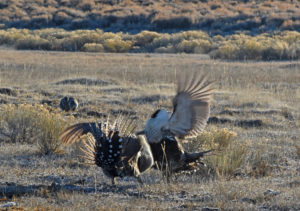For immediate release
July 16, 2019
Contacts:
Erik Molvar, Western Watersheds Project, (307) 399-7910, emolvar@westernwatersheds.org
Randi Spivak, Center for Biological Diversity, (310) 779-4894, rspivak@biologicaldiversity.org
Judi Brawer, WildEarth Guardians, (208) 871-0596, jbrawer@wildearthguardians.org
PORTLAND, Ore.― Conservation groups today won a partial preliminary injunction blocking summer grazing by Hammond Ranches on one of two public lands allotments with sensitive ecological values. A federal judge ordered reduced grazing with monthly monitoring on the other allotment.
Today’s court order, stemming from a lawsuit filed by the conservation groups in May, prevents Hammond Ranches from grazing livestock on the Mud Creek allotment, one of two Bureau of Land Management allotments near Burns, Ore., slated for livestock use this month. In his ruling, the judge also required that grazing on the Hardie Summer allotment be reduced so that livestock use only 30 percent of the vegetation, stating that the reduction to “30 percent utilization across four pastures would allow for significantly fewer cattle.”
“The science is clear and the court understood that resuming livestock grazing will harm the sensitive fish and wildlife on these public lands,” said Erik Molvar, executive director of Western Watersheds Project. “The plants and animals on these public lands have had a reprieve from grazing impacts for years, and have just started to recover, and the BLM’s decision to renew the grazing permit on these allotments failed to consider the consequences of reintroducing cattle to these habitats.”
The lands contain important habitat for greater sage grouse and rare redband trout. U.S. District Judge Michael H. Simon found that livestock grazing degrades the sage-grouse habitats and the trout’s stream habitats. Simon also found that grazing contributes to the spread of the invasive weed cheatgrass, increasing fire risk.
“Grazing permits are a privilege, not a right, and the judge recognized this,” said Randi Spivak, public lands director at the Center for Biological Diversity. “There should be consequences when permittees abuse that privilege. The judge also acknowledged that grazing harms imperiled wildlife and his injunction significantly restricts grazing on sage-grouse and redband trout habitat. That’s a big win for wildlife.”
Experts testified during June 28 and July 2 hearings that resuming grazing after five years of rest from livestock would cause significant damage that should be addressed before cattle are allowed back onto the land.
“Ungrazed landscapes are rare on western public lands,” said Judi Brawer, Wild Places program director at WildEarth Guardians. “The opportunity to see real improvement in these allotments would be set back by Zinke’s top-down decision-making. We’re pleased the court understood that as well.”
On his last day in office, former Interior Secretary Ryan Zinke ordered the BLM to renew grazing permits for Dwight and Steven Hammond in response to President Trump’s 2018 pardon of the Hammonds. The father and son were convicted of setting fires to public lands and endangering the lives of firefighters and the public.
The permittees had a history of permit violations and other bad behavior, and BLM declined to renew the grazing permit in 2014. That decision was still under administrative review when Zinke seized control of the process and ordered BLM to renew the permit in January 2019 during the federal shutdown, which the agency then did without adequate environmental analysis.
In issuing today’s preliminary injunction, the judge recognized that the conservation groups were likely to prevail on key points of their lawsuit; that Zinke had illegally re-issued the grazing permit in light of the past violations of the lease terms, and that the BLM violated the National Environmental Policy Act by re-issuing the permit without a full-fledged environmental analysis.
The judge also rejected arguments that the public lands were at imminent risk from fire without livestock grazing.
The judge ordered the injunction two weeks after two evidentiary hearings that included more than eight hours of witness testimony. The case now moves forward toward a final judgment on the merits of the case.
###






